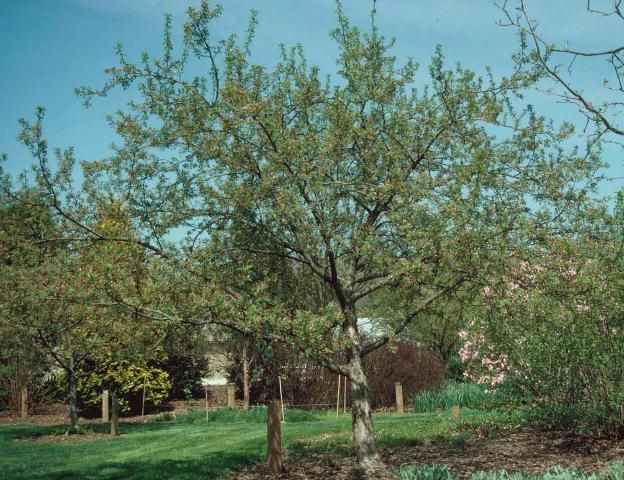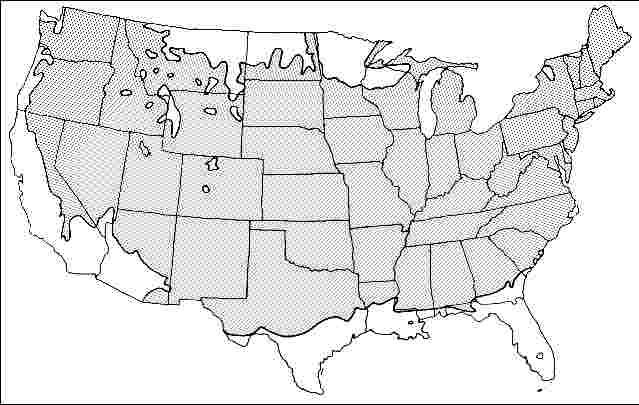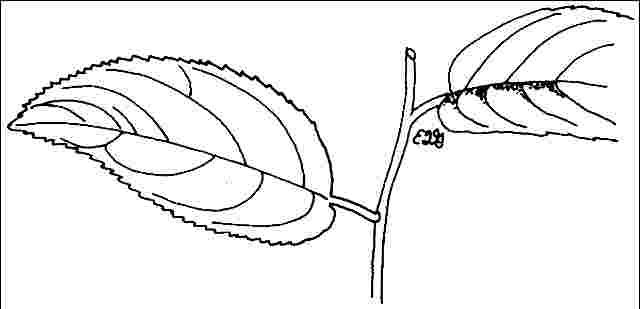Introduction
'Snow Drift' crabapple is a splendid tree and little pruning is required to develop a well-formed, rounded canopy. Unfortunately, it is moderately or severely affected by fireblight disease. There appears to be little variation in shape among trees of this cultivar, a characteristic which is coveted by landscape architects. The bright white flowers in the spring give a refreshing look to the landscape and are followed by small, red-orange fruit eaten by birds. Fall color is good, providing a dull yellow glow for two or three weeks. Some crabapples are alternate bearers, blooming heavily only every other year.

Credit: Ed Gilman, UF/IFAS
General Information
Scientific name: Malus x
Pronunciation: MAY-lus
Common name(s): 'Snowdrift' crabapple
Family: Rosaceae
USDA hardiness zones: 4A through 8A (Fig. 2)
Origin: not native to North America
Invasive potential: little invasive potential
Uses: espalier; specimen; parking lot island < 100 sq ft; parking lot island 100-200 sq ft; parking lot island > 200 sq ft; container or planter; street without sidewalk; deck or patio; tree lawn 3-4 feet wide; tree lawn > 6 ft wide; tree lawn 4-6 feet wide; urban tolerant; highway median; bonsai
Availability: not native to North America

Description
Height: 15 to 25 feet
Spread: 15 to 25 feet
Crown uniformity: symmetrical
Crown shape: round, oval
Crown density: dense
Growth rate: moderate
Texture: medium
Foliage
Leaf arrangement: alternate (Fig. 3)
Leaf type: simple
Leaf margin: serrate, serrulate, crenate
Leaf shape: elliptic (oval)
Leaf venation: pinnate, brachidodrome
Leaf type and persistence: deciduous
Leaf blade length: less than 2 inches, 2 to 4 inches
Leaf color: green
Fall color: yellow
Fall characteristic: not showy

Flower
Flower color: white/cream/gray
Flower characteristics: very showy
Fruit
Fruit shape: round
Fruit length: less than .5 inch
Fruit covering: fleshy
Fruit color: orange, red
Fruit characteristics: attracts birds; showy; fruit/leaves not a litter problem
Trunk and Branches
Trunk/bark/branches: branches droop; not showy; typically multi-trunked; thorns
Pruning requirement: little required
Breakage: resistant
Current year twig color: brown, reddish
Current year twig thickness: thin, medium
Wood specific gravity: unknown
Culture
Light requirement: full sun
Soil tolerances: clay; sand; loam; acidic; alkaline; well-drained; occasionally wet
Drought tolerance: moderate
Aerosol salt tolerance: moderate
Other
Roots: not a problem
Winter interest: yes
Outstanding tree: yes
Ozone sensitivity: unknown
Verticillium wilt susceptibility: resistant
Pest resistance: resistant to pests/diseases
Use and Management
Plants are used as specimens, patios, and along streets to create a bright glow of color each spring. Some pruning to remove and train lower branches is needed along streets and in other areas where vehicular or pedestrian clearance is needed. The pruning requirement can be minimized by specifying tree-form crabapple from the nursery. The trees are attractive during the summer, bearing glossy green foliage and a moderately dense crown. Popular around overhead powerlines due to their small stature, a row of crabapples along each side of the street or median strip can "make" a neighborhood. Select plants which have been grafted onto EMLA 106 or 111 rootstock to reduce root suckering.
They are best grown in a sunny location with good air circulation and have no particular soil preferences, except soil should be well drained. Crabapple is well-adapted to compacted urban soil, tolerates drought and poor drainage well and is somewhat tolerate of salt-spray. Well adapted to all areas within its hardiness zone range, including Texas and Oklahoma. It is a very adaptable tree for urban landscapes. Do not overfertilize since this could increase the incidence of disease. Root pruned trees appear to transplant most easily. Crabapples grow well in the Texas panhandle but are not extremely drought tolerant and are not well suited for high pH soil.
According to the Ornamental Crabapple Society, other crabapples adapted for street tree and urban use include 'Adams', 'Bob White', 'David', 'Donald Wyman', 'Profusion', 'Red Splendor' and Malus floribunda. Be sure to specify tree form plants for street tree use since branching may be too low on trees grown for specimen use. Contact the Ornamental Crabapple Society, Morton Arboretum, Lisle, Illinois 60532 for more information on crabapples.
Other white flowered cultivars include: 'Baccata Columnaris'—narrow crown, white flowers, red or yellow fruit; 'Baccata Gracilis'—slow-growing, shrub-like, white flowers, fruit small and dark red, annual bearer; 'Baccata Jackii'—upright form, white flowers, bright red fruit, annual bearer, also good to excellent disease resistance; 'Callaway'—pink buds, white flowers, red fruit; 'David'—pink buds open to white flowers, scarlet fruit, good to excellent disease resistance; 'Dolgo'—pink buds, white flowers, large red fruits; 'Donald Wyman'—disease-resistant but susceptible to fire blight, glossy red showy fruit; 'Ellwangeriana'—red fruit, disease-resistant; 'Floribunda'—pink to red bud opens to single white flower, yellow or red fruit - commonly available; 'Gloriosa'—pink bud opens to white flower, red, large fruit; 'Golden Hornet'—pright arching habit, white flower, yellow fruit; 'Gorgeous'—pink bud opens to large, white flower, red to orange fruit; 'Harvest Gold'—white flowers followed by yellow fruits; 'Hupehensis'—Tea Crabapple - pink buds open to white flowers, greenish fruit; 'Katherine'—double flowers opening pink, fading to white, fruit yellow and red; 'Mary Potter'—pink buds open to single white flowers, red and fairly large fruit, susceptible to scab and powdery mildew; 'Red Jade'—weeping habit, white flowers, red fruit persisting after leaves drop; 'Sargenti'—dwarf, pink bud opens to white flowers, small dark red fruit; 'Tanner'—white flowers, red fruits, susceptible to diseases; 'Tschonoski'—white flowers, vigorous growth, good bronze red fall color, fruit brownish; 'White Angel'—white flowers, glossy red fruit persisting into winter; 'White Candle'—pink buds open to white flowers, red fruit, upright growth habit; 'Zumi Calocarpa'—white flowers, bright red persistent fruit.
One of the best crabapples for the south is Malus x Callaway.
Disease-resistant cultivars include: 'David', 'Dolga', 'Donald Wyman', 'Ellwangeriana', 'Inglis', 'Jackii', 'Jewelberry', 'Margaret', 'Mary Potter', 'Mount Arbor Special', 'Prairifire', 'Professor Sprenger', and 'Tomiko'.
Pests
Aphids infest branch tips and suck plant juices, and are quite common. They can deform newly emerging foliage and secret honey dew creating a sticky mess beneath the tree, but will not kill the tree.
Fall webworm makes nests on the branches and feeds on foliage inside the nest. Small nests can be pruned out or sprayed with Bacillus thuringiensis. Controlling severe infestations may require other chemicals.
Scales of various types are controlled with horticultural oil.
Borers can be a problem on stressed trees.
Mites are too small to see easily so they can cause much foliage discoloration before being detected. Mites can be controlled to a degree with horticultural oil, but other chemicals are often required by the time mites are detected. The mite infestation can also be severe by the time foliage chlorosis or bronzing is evident.
Eastern tent caterpillar builds tents or nests in trees in early summer or late spring. Feeding occurs on foliage outside the nest. Defoliation can be extensive if infestation is severe, and repeated defoliations for several years can weaken trees. Small nests can be removed by pruning them from the tree. Spray with Bacillus thuringiensis or other approved chemical. Do not burn nests while they are still in the tree.
Diseases
Fairly susceptible to disease.
Scab infection takes place early in the season and dark olive green spots appear on the leaves. In late summer the infected leaves fall off when they turn yellow with black, spots. Infected fruits have black, slightly raised spots. Use resistant varieties to help avoid this severe problem.
Fire blight susceptible trees have blighted branch tips, particularly when the tree is growing rapidly. Leaves on infected branch tips turn brown or black, droop, and hang on the branches. The leaves look scorched as by a fire. The trunk and main branches become infected when the bacteria are washed down the branches. Cankers form and are separated from adjacent healthy bark by a crack. The infected bark may be shredded. Use resistant cultivars when available since severe infections on susceptible trees can kill the tree.
Powdery mildew coats leaves with white fungal growth resembling powder.
Cedar apple rust causes brown to rusty-orange spots on the leaves. Badly spotted leaves fall prematurely, and defoliation can be heavy. Redcedars (Juniperus virginiana) are the alternate host.
Crabapples are subject to several canker diseases. Prune out infected branches, avoid unnecessary wounding, and keep trees healthy.